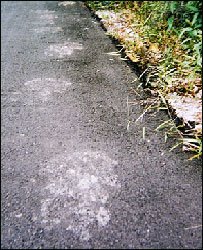
From the BBC, courtesy of JKW:
The village of Mawai Lama in the Malaysian state of Johor is a sleepy row of wooden fronted shop-houses set back from the Sedili River.
Yet Mawai is one of the most intriguing places in Malaysia.
According to local historians, Mawai's original name was Mawas, and Mawas is the name locals give to a legendary creature known the world over as Bigfoot.
The people of Mawas certainly seem to believe in the creature from which their village takes its name.Some, like Aji the boatman, say they have seen it.
"It was about 10 or 11 at night. I saw something, but I didn't know what sort of creature it was. But I can definitely see the eyes were red. And it made a noise, Woooooo!" Aji said.
"Maybe it was scared off by my headlight and I was scared by him so we both rushed off in different directions and later I came back and found the footprints," he said.
The prints (image above) may have been made by Bigfoot. Then again, they also may have been made by an escaped clown.
No comments:
Post a Comment